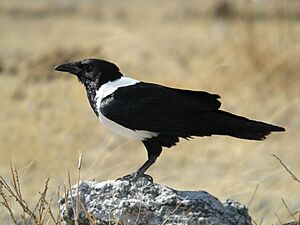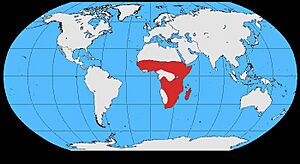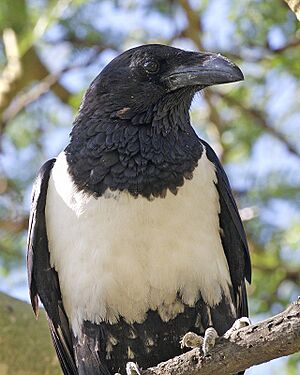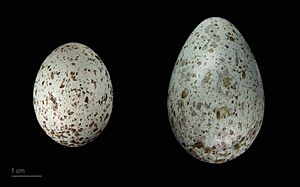Pied crow facts for kids
Quick facts for kids Pied crow |
|
|---|---|
 |
|
| In Etosha National Park, Namibia | |
| Conservation status | |
| Scientific classification | |
| Genus: |
Corvus
|
| Species: |
albus
|
 |
|
The pied crow (scientific name: Corvus albus) is a common bird found across Africa. It belongs to the crow family, called Corvidae. These clever birds are known for their striking black and white feathers.
Pied crows are often thought of as small ravens. This is because they can even breed with the Somali crow, which is a type of dwarf raven. Their behavior is much like the crows found in Europe and Asia. Some scientists believe they might be a link between Eurasian crows and the larger common raven.
Contents
Meet the Pied Crow: What Does It Look Like?
The pied crow is about the same size as a European carrion crow, or a little bigger. It measures about 46 to 50 centimeters long. It has a larger beak, slightly longer tail and wings, and longer legs.
As its name suggests, this crow has a mix of colors. Its head and neck are shiny black. A large white patch covers its shoulders and goes down to its lower chest. The tail, beak, and wings are also black. Its eyes are dark brown. Young pied crows often have some black mixed into their white feathers.
This bird looks a bit like the white-necked raven and the thick-billed raven. However, the pied crow has a much smaller beak.
How to Tell Pied Crows Apart
In southern Africa, you might see pied crows and white-necked ravens in the same areas. Here's how to tell them apart:
- The pied crow is a bit smaller.
- It has a white chest and belly.
- Its beak is black and more slender.
- The white-necked raven is larger.
- It has a black chest and belly.
- Its beak is heavier and has a white tip.
The pied crow is also larger than the cape crow, which is sometimes called the black crow.
What Does a Pied Crow Sound Like?
Pied crows make a harsh sound. People often describe their call as ar-ar-ar-ar or karh-karh-karh.
Pied Crow's Name and History
The pied crow was first described in 1776 by a scientist named Statius Muller. Its scientific name, albus, is a Latin word meaning "white."
The Maasai people in Africa call this bird ol-korrok. This name comes from the sound of its call. They find the bird a bit annoying, but they don't believe it brings bad luck.
Where Do Pied Crows Live?
The pied crow is the most widespread crow species in Africa. You can find it in many countries south of the Sahara Desert. This includes places like Nigeria, Ghana, Senegal, Sudan, Somalia, Eritrea, Zambia, Botswana, Mozambique, and Zimbabwe. They also live south to the Cape of Good Hope. You can even find them on large islands like Madagascar, the Comoros Islands, and Zanzibar.
These birds mostly live in open areas near villages and towns. They don't live in the thick rainforests near the equator. Pied crows are usually found close to people. However, in Eritrea, you might see them far from human homes. They are not as tied to city life as the house crow found in Asia.
Pied Crow Behavior
Pied crows are usually seen in pairs or small groups. If there's a lot of food available, many birds might gather together. They act in ways similar to other crows, like the hooded crow. In the city of Dakar, people have seen pied crows bothering ospreys and snake eagles as they fly by. However, they tend to avoid black kites.
What Do Pied Crows Eat?
Pied crows find all their food on the ground or in trees. They eat many different things! Their diet includes:
- Insects and other small invertebrates (like worms).
- Small reptiles.
- Small mammals.
- Young birds and eggs.
- Grains and peanuts.
- Carrion (dead animals).
- Any scraps of human food and fruit.
They have even been seen catching and eating fruit bats that are resting. You can often see huge numbers of pied crows looking for food around slaughterhouses.
Reproduction and Life Cycle
Pied crows usually build their nests in tall, single trees. If tall trees aren't available, they might use smaller ones. They also often build nests on the cross supports of telephone poles. Both the male and female crow help build the nest.
A female crow lays three to six eggs. The eggs are pale green with brown spots. They are laid between September and November, depending on the location. The female usually covers the eggs when she leaves the nest. The eggs hatch after about 18 to 19 days. The young birds are ready to fly after about 45 days. Both parent birds help raise the young.
See also
- Cape crow (also known as the black crow)






